

Parker 1.0 mm lead pencil converter. By the 1930s, lead sizes for American mechanical pencils had been thoroughly standardized.
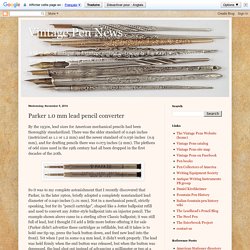
There was the older standard of 0.046 inches (metricized as 1.1 or 1.2 mm) and the newer standard of 0.036 inches (0.9 mm), and for drafting pencils there was 0.075 inches (2 mm). The plethora of odd sizes used in the 19th century had all been dropped in the first decades of the 20th. So it was to my complete astonishment that I recently discovered that Parker, in the later 1960s, briefly adopted a completely nonstandard lead diameter of 0.040 inches (1.01 mm). Not in a mechanical pencil, strictly speaking, but for its "pencil cartridge", shaped like a Jotter ballpoint refill and used to convert any Jotter-style ballpoint into an injector pencil. According to Jotter: History of an Icon, p. 204, Parker's pencil cartridge was introduced in 1968 (other authorities specify that it was at the beginning of that year). BALLPOINT PENS. The Battle of the Ballpoint Pens - Ladislo Biro.
By Mary Bellis "No man was more foolish when he had not a pen in his hand, or more wise when he had" - Samuel Johnson.
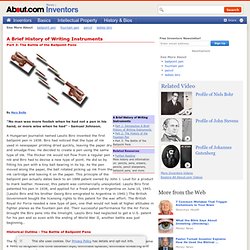
Pentrace (:>> Fountain Pens. BillsPens.com. Pens & Accessories. Antique Pens Quill Dip Pens: Quill pens were in use by the year 600.
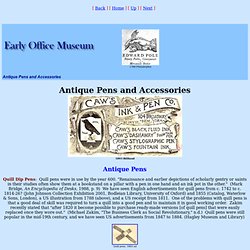
"Renaissance and earlier depictions of scholarly gentry or saints in their studies often show them at a bookstand on a pillar with a pen in one hand and an ink pot in the other. " (Mark Bridge, An Encyclopedia of Desks, 1988, p. 9) We have seen English advertisements for quill pens from c. 1742 to c. 1814-26? (John Johnson Collection Exhibition 2001, Bodleian Library, University of Oxford) and 1855 (Catalog, Waterlow & Sons, London), a US illustration from 1788 (above), and a US receipt from 1811.
Common pen repairs. Common fountain pen repairs and adjustments Typically, when you find a fountain pen "in the wild," it is going to require a bit of refurbishment (or at least a good cleaning and polish) to get it back into proper shape.
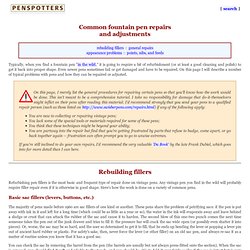
Even newer pens sometimes fail or get damaged and have to be repaired. On this page I will describe a number of typical problems with pens and how they can be repaired or adjusted. Rebuilding fillers Refurbishing pen fillers is the most basic and frequent type of repair done on vintage pens. Basic sac fillers (levers, buttons, etc.) Duofold « Fountain Pen Restoration. P.

W. Akkerman Button Filler This week’s restoration comes to me from across the Atlantic ~ a P. W. Akkerman Button filler, from the Netherlands. Below is a photograph of the pen after I have taken it apart. As with most button fill repairs, the pressure bar also needed replacing as this one had lost its rigidity. I fit a size 16 sac to the cleaned nib/feed/section and screwed this back into the barrel with the assistance of a bit of silicon grease. Finally, I inserted the new blind cap and clip cap to the cap and barrel, producing the pen below.
Conway Stewart collectable fountain pens.
Nib Comparison Chart : Fountain pen. Caran d'ache pens. The Nib Section. Fountain Pens by Richard Binder. How to replace a fountain pen nib. All About Nibs. The nib is the heart of the fountain pen; it is the only part that touches paper and this is the most important part in determining writing performance.

Pictured above are the nibs and feeds from a Cross Solo and a vintage Waterman 52 1/2 V. Tip/Point The tip of the nib is usually a pellet of hard metal soldered to the nib. Steel and especially gold will wear out very quickly, so a harder material is required to ensure the longevity of the pen. This material is often refered to as iridium, although it is not necessarily iridium. Slit. The Pen Museum. Fp_nib_replacement. Basic Fountain Pen Restoration, Part I. So, you've discovered a cup'o'pens at the local flea market, and found that amidst all the cheap Bics and broken mechanical pencils are a few fountain pens.
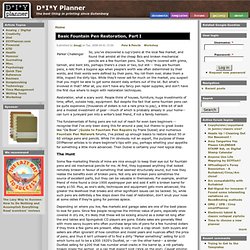
Sure, they're covered with grime, tarnish, and bent bits, perhaps there's a crack or two, but still -- they are fountain pens, a relic from a bygone age when people's worth was often determined by their words, and their words were defined by their pens. You roll them over, shake them a little, inspect the dirty tips. While they'll never sell for much on the market, you suspect that you might be able to get some decent daily writers out of the lot. But what's involved in that? After all, you don't have any fancy pen repair supplies, and don't have the first clue where to begin with restoration techniques. Article #052501085 Fountain Pen Nibs: The Basics.
Fountain pen nibs are made in a bewildering array of sizes and styles.
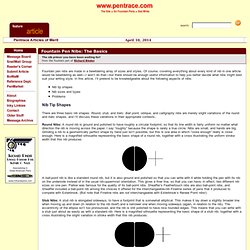
Of course, covering everything about every kind of nib in one article would be bewildering as well—I won’t do that—but there should be enough useful information to help you better decide what nibs might best suit your writing style. In this article, I’ll pretend to be knowledgeable about the following aspects of nibs: Nib tip shapes Nib sizes and types Problems Nib Tip Shapes There are three basic nib shapes: Round, stub, and italic. Round Nibs: A round nib is ground and polished to have roughly a circular footprint, so that its line width is fairly uniform no matter what direction the nib is moving across the paper. Vintage Fountain Pens. Waterman Safety Repair. Up until now, restoration of Waterman safety pens has typically been categorized as advanced repair.
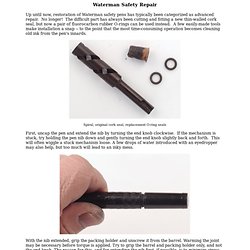
No longer! The difficult part has always been cutting and fitting a new thin-walled cork seal, but now a pair of fluorocarbon rubber O-rings can be used instead. A few easily-made tools make installation a snap -- to the point that the most time-consuming operation becomes cleaning old ink from the pen's innards. Spiral, original cork seal, replacement O-ring seals First, uncap the pen and extend the nib by turning the end knob clockwise. Fountain Pen Repair & Restoration.